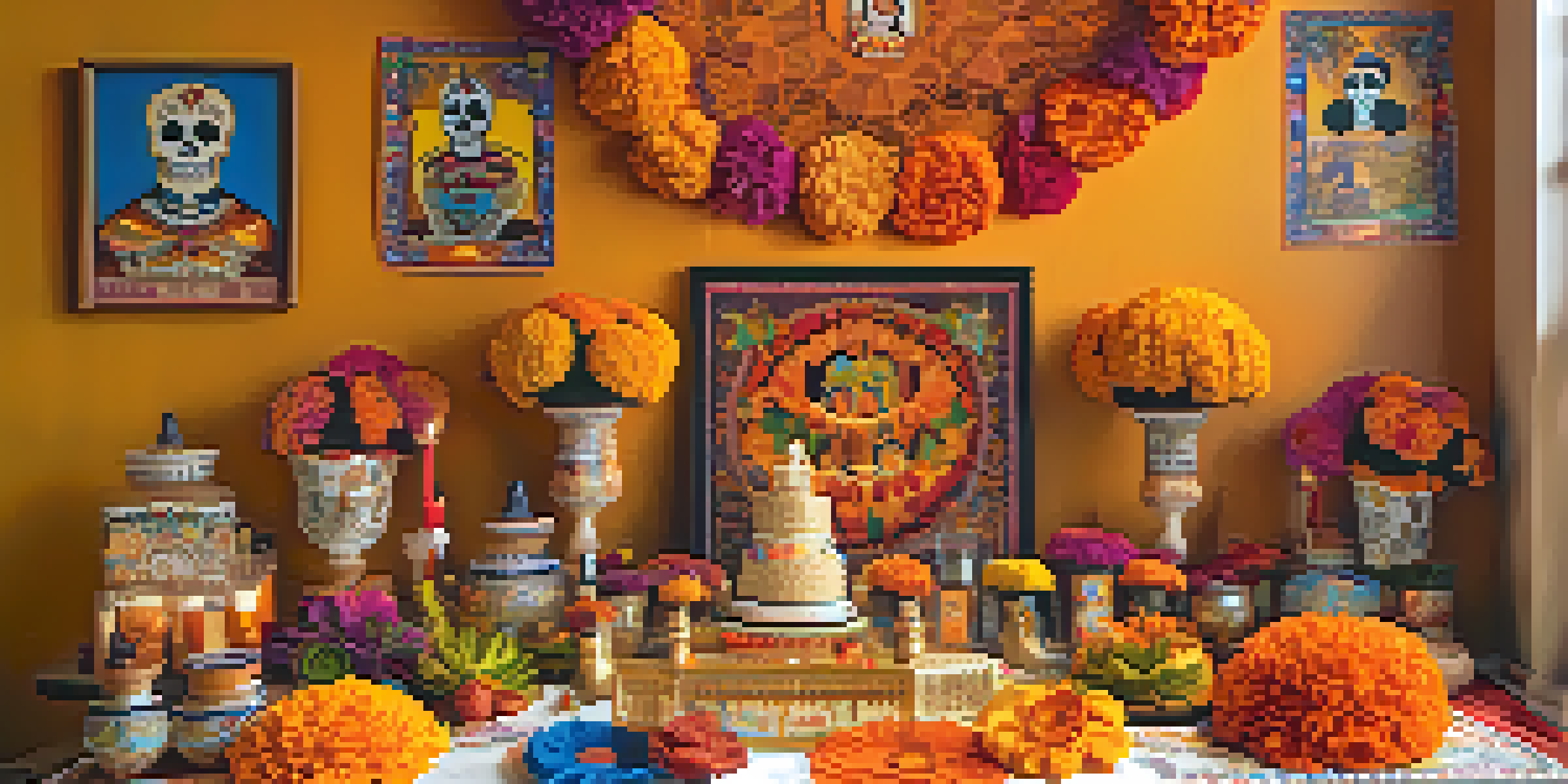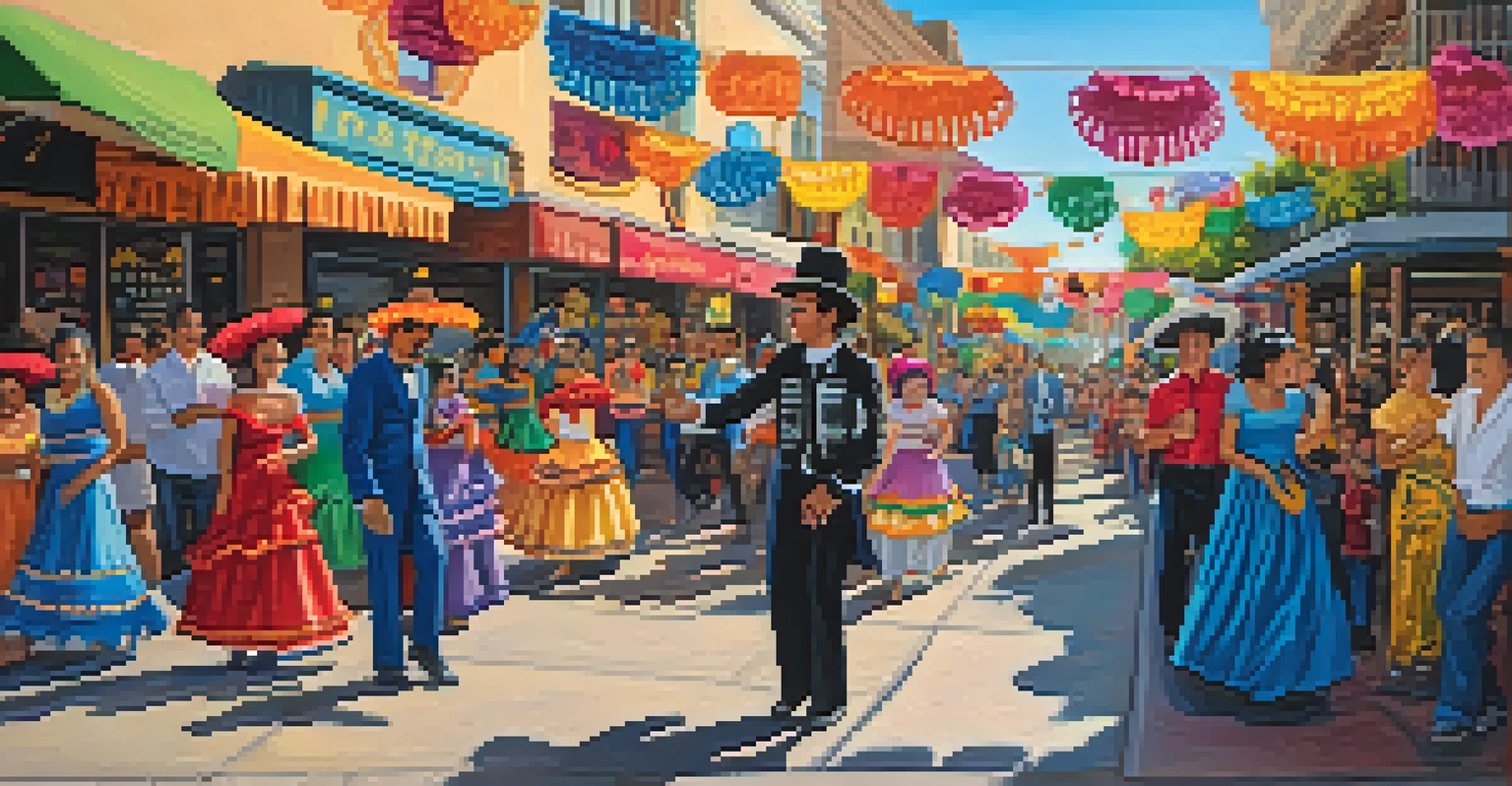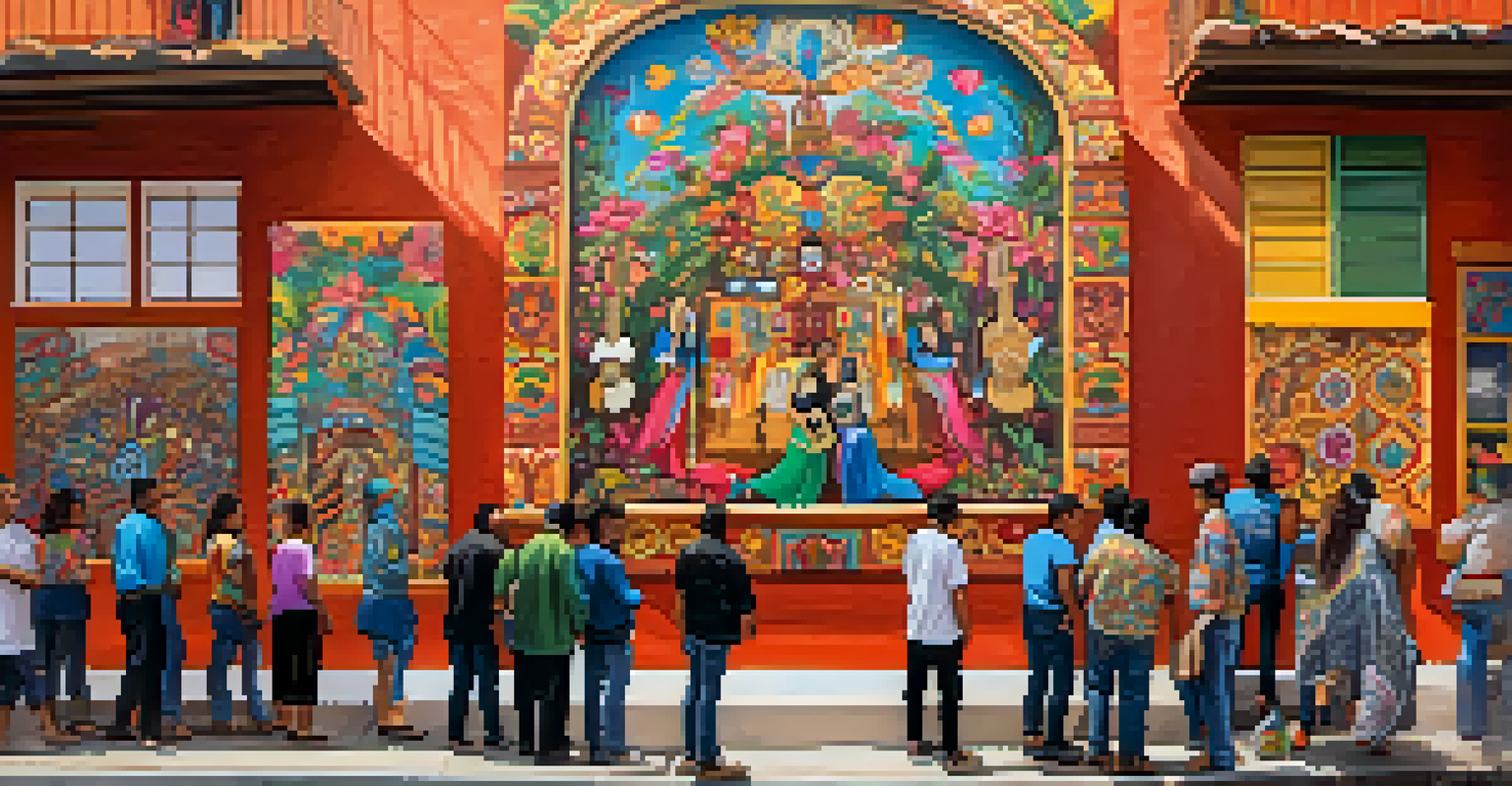San Antonio's Día de los Muertos: A Celebration of Life

Understanding Día de los Muertos: Its Origins and Significance
Día de los Muertos, or Day of the Dead, is a rich tradition rooted in Mexican culture, blending ancient indigenous beliefs with Spanish influences. It's celebrated on November 1st and 2nd, coinciding with the Catholic holidays of All Saints' and All Souls' Days. The holiday honors deceased loved ones, creating a space for remembrance and celebration rather than mourning.
To live in hearts we leave behind is not to die.
This celebration is marked by vibrant altars, known as ofrendas, adorned with photographs, favorite foods, and mementos of the departed. Each item tells a story, reflecting the personality and passions of those who have passed away. It's a beautiful reminder that while life is fleeting, the bonds we share endure.
In San Antonio, this tradition thrives, infused with local culture and community spirit. From colorful marigolds to sugar skulls, the city transforms into a tapestry of remembrance, inviting everyone to join in the celebration of life and legacy.
The Heart of San Antonio: Community Celebrations and Events
San Antonio's Día de los Muertos festivities are a vibrant reflection of community spirit. Events range from intimate family gatherings to large public celebrations, drawing locals and tourists alike. The city's rich cultural tapestry is on full display, showcasing the diversity and unity of its residents.

One of the most notable events is the annual Día de los Muertos Festival at Hemisfair, which features live music, food vendors, and art exhibitions. Families come together to create elaborate altars, while artists showcase their talents through murals and performances. This festival not only honors the dead but also celebrates the living, fostering a sense of belonging and connection.
Día de los Muertos Celebrates Life
This vibrant tradition honors deceased loved ones through joyful remembrance, emphasizing celebration over mourning.
These communal events encourage participation, allowing everyone to contribute their own memories and stories. Whether you're painting a sugar skull or dancing to traditional music, each activity strengthens the community's bond, making the celebration a collective experience filled with joy.
Artistic Expressions: Murals and Altars in San Antonio
Art plays a pivotal role in San Antonio's Día de los Muertos celebrations, with murals and altars transforming public spaces into vibrant galleries. Local artists use their creativity to depict the stories of the departed, often incorporating elements of Mexican folklore. These artistic expressions resonate with both the community and visitors, evoking a sense of connection to the past.
Death is nature's way of telling you to slow down.
Murals, in particular, serve as a canvas for storytelling, featuring iconic imagery such as calacas (skeletons) and calaveras (skulls). Each mural invites viewers to reflect on the lives and legacies of those who have passed, while also celebrating the culture itself. This blend of art and remembrance creates a dynamic atmosphere that engages the senses.
The altars, or ofrendas, are just as artistic, showcasing a personal touch from families and friends. Each element, from the papel picado (perforated paper) to the traditional foods, is carefully chosen to honor the deceased. This blend of artistry and emotion makes the celebration a unique experience for everyone involved.
Traditional Foods: A Taste of Día de los Muertos
Food is an essential part of Día de los Muertos, with traditional dishes playing a significant role in the celebrations. Families prepare favorite meals of their departed loved ones, creating a feast that brings everyone together. From tamales to pan de muerto (a sweet bread), these culinary delights are both a tribute and a means of sharing love and memories.
One of the standout dishes is pan de muerto, often decorated with bone-shaped motifs. This bread symbolizes the cycle of life and death, and its sweet aroma fills homes during the celebration. Sharing these dishes with family and friends fosters a sense of community and connection, embodying the spirit of togetherness that Día de los Muertos represents.
Community Spirit in San Antonio
San Antonio's festivities showcase unity and diversity, inviting everyone to participate in creating a collective experience.
In San Antonio, food vendors at festivals showcase a variety of traditional offerings, allowing attendees to experience the flavors of the holiday. Tasting these dishes becomes a way for people to engage with the culture, making the celebration not just a visual feast but also a delightful culinary journey.
Music and Dance: The Rhythms of Día de los Muertos
Music and dance are integral components of San Antonio's Día de los Muertos celebrations, adding a lively spirit to the remembrance. Traditional mariachi bands, folkloric dancers, and local musicians fill the air with vibrant sounds, inviting everyone to join in the festivities. This rhythmic expression enhances the celebratory atmosphere, blending joy with remembrance.
Each performance is a tribute, often telling stories of the deceased through lively music and dance. The movements of the dancers and the melodies of the musicians create a connection between the living and the dead, celebrating life in all its forms. It's a beautiful reminder that while we may grieve, we also celebrate the moments that brought us joy.
In public events, everyone is encouraged to dance, creating a sense of unity among attendees. Whether you’re a seasoned dancer or just moving to the beat, the energy is contagious, reinforcing the idea that Día de los Muertos is a celebration of life—an opportunity to honor the past while embracing the present.
Family Involvement: Creating Personal Ofrendas
Creating an ofrenda is a deeply personal experience for families celebrating Día de los Muertos. Each altar reflects the unique stories and memories of loved ones, filled with items that showcase their lives. This process fosters family bonding, as relatives come together to share anecdotes and select meaningful offerings.
Common elements of an ofrenda include photographs, favorite foods, and items representing hobbies or passions of the deceased. This personalization transforms the altar into a living tribute, inviting the spirit of the departed to join the festivities. It’s a heartwarming way to keep memories alive, ensuring that those we love are never truly gone.
Art and Tradition Merge Creatively
Murals and personalized ofrendas reflect the stories of the departed, turning public spaces into dynamic galleries of remembrance.
Families often involve children in this tradition, teaching them the significance behind each item placed on the altar. This not only preserves cultural heritage but also strengthens familial bonds, creating lasting memories. Through this involvement, the younger generation learns to celebrate life while honoring those who came before them.
The Future of Día de los Muertos in San Antonio
As San Antonio continues to grow and evolve, so does its celebration of Día de los Muertos. New generations are embracing this tradition, infusing it with modern elements while keeping its cultural roots intact. This blend of old and new ensures that the spirit of the celebration remains vibrant and relevant.
Community leaders and cultural organizations are actively promoting awareness and education about Día de los Muertos, making it accessible to everyone. Workshops, art exhibits, and educational programs help foster a deeper understanding of the holiday's significance, encouraging participation from diverse communities. This dedication to inclusivity enriches the celebration, showcasing the beauty of cultural exchange.

Looking ahead, the future of Día de los Muertos in San Antonio promises to be even more dynamic. As the city continues to embrace its multicultural identity, the celebration will undoubtedly grow, creating new traditions while honoring the past. This evolution ensures that Día de los Muertos remains a cherished part of the community's fabric, celebrating life in all its forms for generations to come.